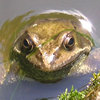From tadpoles to froglets
The tadpoles had been swimming in the pond through the spring. In the third week in June 2004 small dark shapes began to emerge onto the rocks at the edge of the wildlife pond, from the shallow edges. At the slightest movement suggesting danger (like the approach of Rosie the cat) the tiny frogs would wriggle back into the water.
Sitting quietly, you could watch them emerge again, and the way they left the water in a way that looked awkward and new, as they literally found their legs on land. Their movement at the water's edge was from swimming, to hopping, so awkward at first that they seemed to swim onto the rocks, kind of slithering out of the water.
The newly emerged froglets are so tiny it is hard to believe that they are ready to be out of the water. It is hard to believe that they will grow into the more familiar-sized adult frogs. But they do, and I know how much they grow because last year's tiny froglets are around the garden too. These are part grown, smaller sized frogs, that have overwintered in the garden.
The importance of shallow pond edges
The pond was created with shallow edges on two of its sides, following the guidelines for creating wildlife-friendly ponds. The pond tapers out in one area to a very shallow part with only a centimetre or two of water, and flat rocks and plants provide extra help to small frogs needing to find the dry land. Having seen how tiny these newly-emerging frogs are, I can now fully understand why these shallow areas are necessary.
And planting for cover
There's plain old ivy around much of the pond. Ivy is seen as a boring plant, by many people, but I've found there's nothing better for concealing the edges of a pond and providing cover for frogs. Beyond the ivy I've tried to plant other things that will provide good cover at ground level - a tangle of plants that the emerging frogs can hide under. Such small creatures are vulnerable to predators, and I imagine they won't get far if they have to cross a lot of barren earth. (Though as my garden is generally over-planted, with plants crammed in everywhere, bare earth is very rare!)
Year-old frogs
From the first frogspawn in 2003, I wondered how many of the tiny creatures would survive the winter. Quite a few, it seems. In spring 2004, while working in the garden, I came across many small frogs, obviously from the previous year's spawn. These varied in size, the smallest being not much bigger than a woodlouse. They seemed to be in the brick edging around the mini-lawn, rather than by the pond edge. The brick edging in that area is just two layers of brick laid on top of one another and unmortared, so there are lots of spaces between. The smaller frogs seemed to hide in these gaps.
I've taken a lot of photographs of frogs, at different stages in their growth. A selection appears on this page. There are also a few larger photographs of wildlife on a separate page.
All photos: © Turning Earth
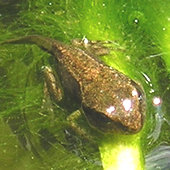
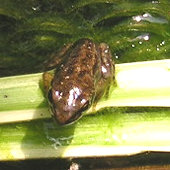
Above: a froglet, left, with short tail remaining, and right, another froglet with tail gone, sitting on the leaves of a pond plant
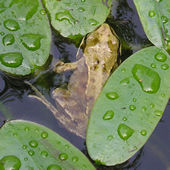
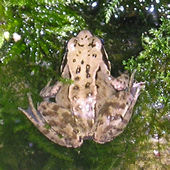
Above: small frogs from the previous year's frogspawn, in June 2004, in the pond
Frogs young and old, and watching out for them
The pond is now home to all sizes of frog, from the fully mature adults who mate and produce spawn, through the year-old frogs from last spring, to the emerging froglets of this spring.
At first it was a bit alarming to find frogs appearing when I was tidying a border or cutting the grass. I think about them now, and, for example, cut the grass before the froglets left the pond, because once they've left the water they tend to hide in the grass for a while, and would be in danger of being injured by lawnmowers and strimmers. So the grass will be left uncut for a while. (Good excuse to avoid a boring task.)
I wouldn't have introduced frogs into my garden deliberately, and didn't intend to have a garden pond. But the frogs arrived, so I made the pond, and now there are frogs everywhere. I hope they're eating the slugs and protecting my hostas.
Now I've got used to them and their habits. They're fascinating creatures, and rather calming to watch, the way they sit in and around the pond on a sunny day, just being frog-like. They're rather nice to have around.
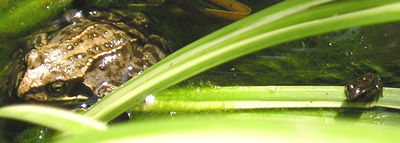
Photo: a fully-grown frog (left) with a tiny 2004 froglet (right) in the pond plants, June 2004.
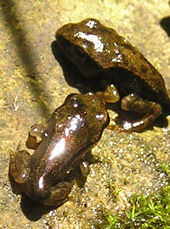
Tiny froglets from the 2004 frogspawn emerging onto land, 22 June 2004.
Below: A small froglet (circled in the picture) emerges from the water via the convenient platform of an adult frog's head. The larger frogs, sitting in the pond, are from the frogspawn of 2003.
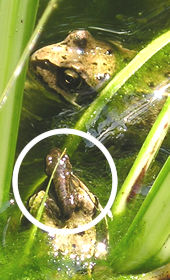
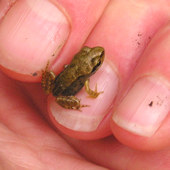
Above: to paraphrase the proverb, a froglet in the hand is worth - well, a photo at least. Tiny 2004 froglet, on 1 July 2004, discovered on the grass - and moved in case I trod on it.

